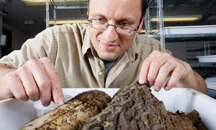Pesky ants found in Hawaii demonstrate invasive characteristics

Grzegorz Buczkowski said odorous house ants, native to the mainland United States, have invaded Hawaii and are forming large colonies. (Purdue Agricultural Communication file photo/Tom Campbell)
WEST LAFAYETTE, Ind. - A common pest in the mainland United States known for its tropical smell now has a tropical habitat to go along with it.
Odorous house ants - so called because they tend to invade houses and smell like coconut when smashed - have found their way to Hawaii. And, according to Purdue University entomologist Grzegorz Buczkowski, it doesn't seem as though they have plans to end their vacations.
"Odorous house ants in Hawaii are not like they are here in natural areas where they live in small colonies. They are creating megacolonies like they do in urban areas," said Buczkowski, whose findings were published in the journal Myrmecological News. "We went there to eliminate the ants, but we found it's too late to treat for them."
In the continental United States, odorous house ants are especially troublesome because they are difficult to remove, Buczkowski said. A nest might be eliminated at one house, but other nests could be in nearby yards, allowing the ants to come back.
"It's one of the worst, if not the worst, pest species in homes," Buczkowski said.
Buczkowski said it's too soon to know what the effect of odorous house ants will be on Hawaii's native plant and animal species, but he wants to monitor the ecosystem around their nests.
Of concern is how the ants might react to Hawaii's climate. On the mainland, odorous house ants go dormant in winter, but with Hawaii's favorable year-round temperatures, the ants could continue to eat and expand much faster than in their native range.
In natural settings, odorous house ants live about 50 to a colony with one queen, often taking up residence in acorns or other small spaces. But Buczkowski's previous research has shown that when odorous house ants move into urban areas, colony sizes explode. On the Purdue campus, for example, Buczkowski has found a colony with 5 million workers and about 25,000 queens.
In Maui, the ants are taking up residence on the western slopes of the Haleakala volcano among some small farms, somewhat like the natural settings where the ants are found on the mainland. But despite a more natural setting in Maui, they're forming large colonies. Buczkowski said he estimated the Maui invasion is a single supercolony with more than 300 nests and multiple queens per nest covering more than 45 acres.
It's likely the ants stowed away on a ship, but Buczkowski said he's still stunned they made such a long journey from their native area.
"They aren't supposed to be in Hawaii," Buczkowski said. "To go from the mainland to Hawaii, more than 2,500 miles over the sea, is amazing."
The ants are also thriving among several inhospitable ant species, such as invasive Argentine and big-headed ants, which are aggressive toward other ant species.
"They didn't just invade a place that was free of ants and gain a foothold. They are in the middle of other ants and thriving," Buczkowski said. "If odorous house ants can get established there, they can get established anywhere. They could be invasive anywhere in the world."
The U.S. Department of Agriculture National Institute of Food and Agriculture and DuPont funded Buczkowski's research.
Writer: Brian Wallheimer, 765-496-2050, bwallhei@purdue.edu
Source: Grzegorz Buczkowski, 765-494-6314, gbuczkow@purdue.edu
Ag Communications: (765) 494-2722;
Keith Robinson, robins89@purdue.edu
Agriculture News Page
ABSTRACT
The Odorous House Ant, Tapinoma Sessile (Hymenoptera: Formicidae), as a New Temperate-Origin Invader
Grzegorz Buczkowski & Paul Krushelnycky
A population of the odorous house ant, Tapinoma sessile, was found at an upland site on Maui, Hawaii. Although T. sessile possesses many of the traits shared by most invasive ant species and is a significant urban pest in the continental USA, this represents the first confirmed record for this species outside its native North American range. Our survey of the site revealed a relatively large (ca. 17 ha) infestation with many closely spaced nests, possibly all belonging to a single supercolony as suggested by the lack of aggression or only occasional non-injurious aggression between workers from distant nests. The odorous house ant is currently abundant at this site, despite the presence of seven other introduced ant species, including the big-headed ant (Pheidole megacephala) and the Argentine ant (Linepithema humile). Based on its behavior at this site, T. sessile may successfully invade other temperate areas in the future, and should be watched for by biosecurity programs.
